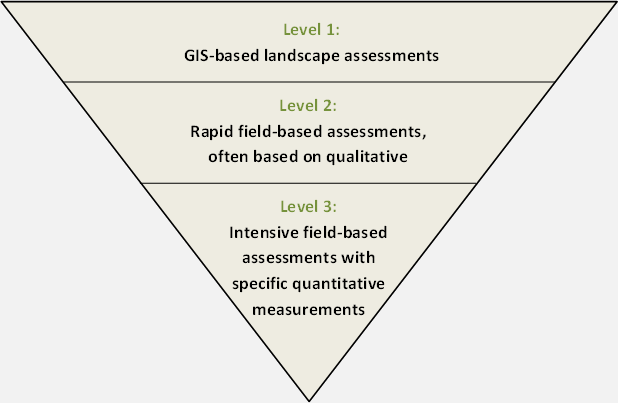Wetlands provide many important benefits to the people of Colorado through the ecological functions they perform. Wetlands in good condition are better able to provide those benefits than wetlands that have been heavily impacted. Assessment and monitoring programs are essential for measuring the quality of wetland health and the level of functions they perform. Wetland assessment projects provide baseline information on the ecological condition, habitat quality, or biological significance of wetlands in order to inform management decisions and help target restoration or conservation projects. Long-term monitoring, in which sites are visited multiple times over several years, can reveal changes in wetland condition over time.

Level 1-2-3 Framework for Wetland Assessment
Because it is impossible to visit every wetland to determine its condition, the U.S. Environmental Protection Agency (EPA) recommends a three-tiered approach to wetland assessment. The Level 1-2-3 framework for wetland assessment and monitoring is a hierarchical approach that involves increasing degrees of effort and cost with each increasing level of assessment.
- Level 1 (landscape assessment) relies on coarse, landscape scale inventory information, typically gathered through remote sensing and preferably stored in, or convertible to, a geographic information system (GIS) format.
- Level 2 (rapid assessment) is at the specific wetland site scale, using relatively simple, rapid protocols.
- Level 3 (intensive site assessment) uses intensive research-derived, multi-metric indices of biological integrity. Nearly all assessment methods in use today fit within one or more levels of this paradigm.


Ecological Condition Assessment Methods
CHNP has developed ecological condition assessment methods for all three levels within the Level 1-2-3 Framework. In addition to protocols developed by CNHP, several wetland and riparian assessment protocols are used by various Colorado agencies and partners.
Visit the Assessment Methods Page
Habitat Quality Assessment Methods
Wildlife habitat is among the most critical functions wetlands provide. CNHP and parnters have developed factsheet and habitat scorecards to help landowners and land managers understanding habitat needs of priority wetland-dependent wildlife.
Visit the National Wetland Condition Assessment Page
Biodiversity Significance
Wetlands are among the most diverse ecosystems in Colorado. Since 1992, CNHP has partnered with public, non-profit, and private entities to conduct surveys of critical biological resources for counties and/or watersheds.
Visit the National Wetland Condition Assessment Page
Colorado Wetland Assessment Projects
In 2008, CNHP began a series of field projects to assess the condition of wetlands in Colorado’s major river basins. Our goal is to survey each of the major river basins on a rotating schedule every 10 to 15 years.
Visit the Basinwide Assessments Page
National Wetland Condition Assessment
The National Wetland Condition Assessment (NWCA) is a collaborative survey of the nation's wetlands. CNHP is an active participant of the NWCA and coordinated sampling in Colorado for both the 2011 and 2016 surveys.
Visit the National Wetland Condition Assessment Page



